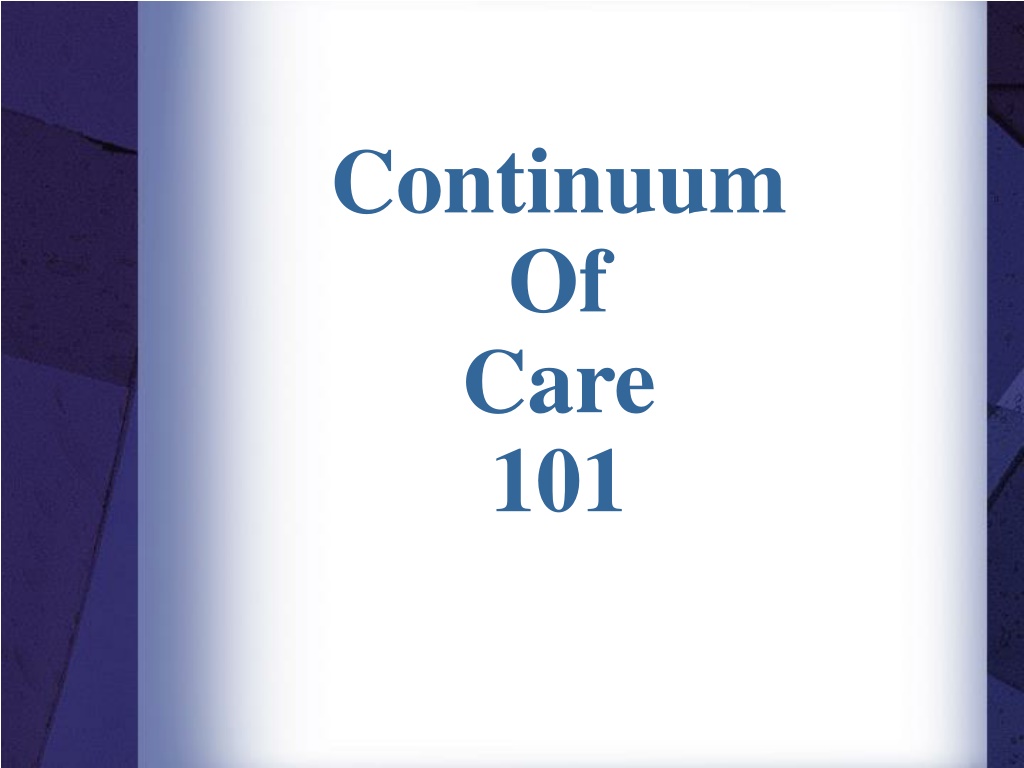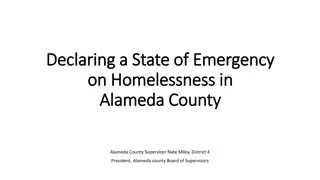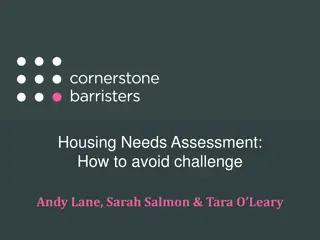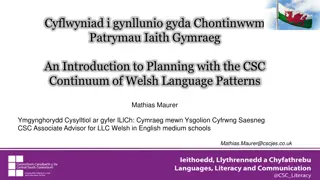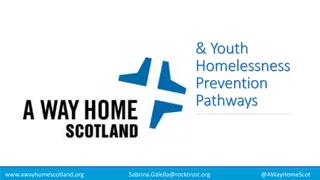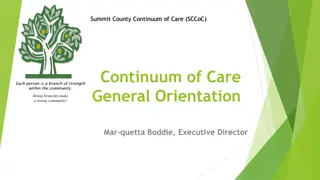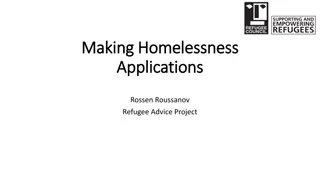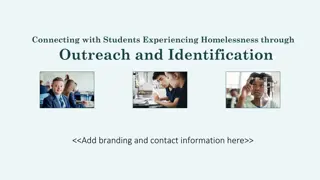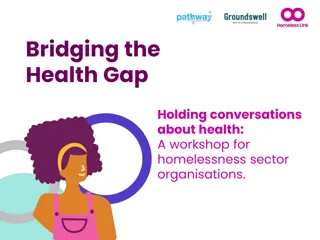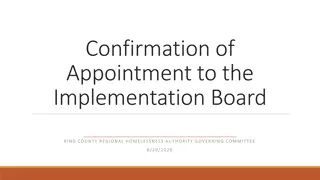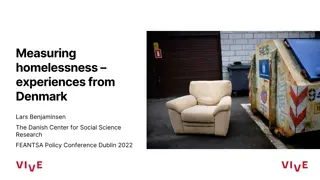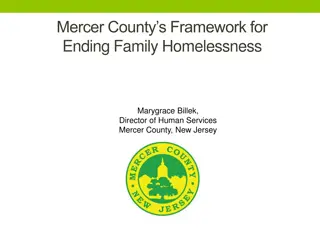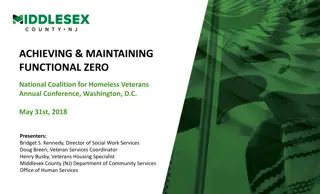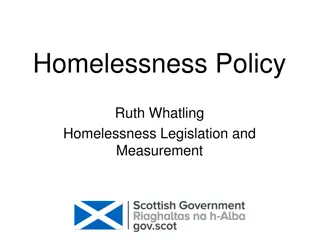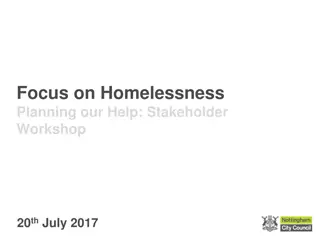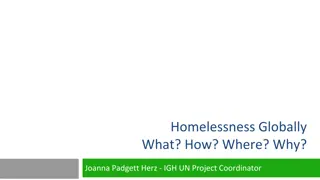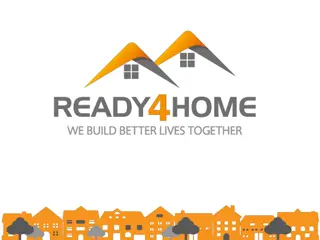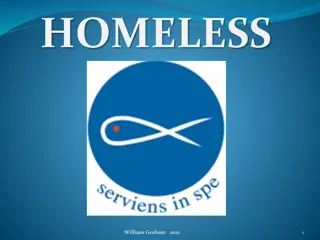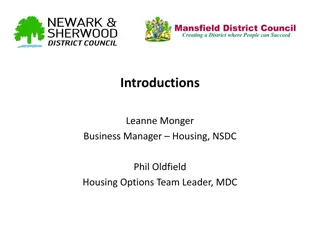Continuum of Care in Ending Homelessness
The Continuum of Care (CoC) program aims to promote community commitment to ending homelessness, re-house homeless individuals quickly, and improve access to mainstream programs. CoCs have specific responsibilities to achieve these goals, involving collaboration and funding efforts for homeless support. The HUD CoC program and the HEARTH Act play key roles in shaping homeless assistance initiatives.
Download Presentation

Please find below an Image/Link to download the presentation.
The content on the website is provided AS IS for your information and personal use only. It may not be sold, licensed, or shared on other websites without obtaining consent from the author.If you encounter any issues during the download, it is possible that the publisher has removed the file from their server.
You are allowed to download the files provided on this website for personal or commercial use, subject to the condition that they are used lawfully. All files are the property of their respective owners.
The content on the website is provided AS IS for your information and personal use only. It may not be sold, licensed, or shared on other websites without obtaining consent from the author.
E N D
Presentation Transcript
Continuum Of Care 101
The Presenter Partners Ending Homelessness The Rochester/Monroe County Homeless Continuum of Care Charles Bollinger III, Programs Coordinator cbollinger@letsendhomelessness.org 585-319-5091 ext 101 (Hey that s me)
HEARTH Act The Hearth Act reauthorized The McKinney Vento Homelessness Assistance Act with the following changes: Consolidate HUD s competitive grant programs Codify the Continuum of Care planning process Change HUD s definition of homelessness Increase in prevention resources Increased emphasis on performance & outcomes
Homelessness Defined by HUD vs D.O.E HUD D.O.E Literally Homeless Doubled up with family or friends Residing in hotel or motels (paid by family ) Residing in an emergency shelter or transitional housing (Homeless for HUD as well) Unsheltered (Homeless for HUD as well) Imminent Risk of Homelessness Homeless under other Federal Statutes Fleeing and/or attempting to flee domestic violence
What is the Continuum of Care?
The HUD CoC Program Purpose Promote Community wide commitment to end homelessness Quickly re-house homeless individuals and families Improve access to and use of mainstream programs
What is the Continuum of Care? The CoC according to HUD is the group responsible for carrying out the duties defined in the Continuum of Care Program Interim Rule. The CoC is composed of representatives of relevant organizations within the geographic area served by the Continuum. Once established, the CoC is required to appoint a CoC board and to designate an HMIS lead agency and a collaborative applicant to assist with its responsibilities.
Responsibilities of the CoC In establishing a CoC, communities must bear in mind that CoCs are designed to: Promote a community-wide commitment to the goal of ending homelessness Provide funding for efforts for rapidly re-housing homeless individuals and families Promote access to and effective use of mainstream programs Optimize self-sufficiency among individuals and families experiencing homelessness
HMIS Lead Agency The HMIS Lead agency is the eligible CoC applicant designated by the CoC to oversee the day- to-day operations of the HMIS Rochester/Monroe County Continuum of Care is the HMIS Lead Agency and has all the HMIS responsibilities
HUD ~ Acronyms Annual Homeless Assessment Report (AHAR) Annual Performance Report (APR) ConsolidatedAnnual Performance and Evaluation Report (CAPER) Department of Housing and Urban Development (HUD) Homeless Management Information System (HMIS) Housing Inventory Count (HIC)
HUD ~ Acronyms Continued Permanent Housing (PH) Permanent Supportive Housing (PSH) Point-in-Time(PIT) Rapid Re-Housing (RRH) Transitional Housing-Rapid Re-Housing(TH-RRH) Request for Proposal (RFP) Runaway and Homeless Youth (RHY) Support Services Only (SSO) Transitional Housing (TH) Vulnerability Index & Service Prioritization Decision Assistance Tool (VI-SPDAT)
HUD ~ Terms Annual Homeless Assessment Report (AHAR) is a HUD report to the U.S. Congress that provides nationwide estimated of homelessness, including information about the Demographic characteristics of homeless person, services as patterns and the capacity to house homeless person. The report is based primarily on Homeless Management Information System (HMIS) data about person who experience homelessness during a 12-month period. Annual Performance Report (ARP) Recipients of HUD funding thought the homeless grant competition are required to submit an Annual Performance Report (APR) electronically to HUD, via SAGE every operating year. The APR is required of projects funded with HUD CoC grant funding. Consolidated Annual Performance and Evaluations Report (CAPER) the consolidated Plan is carried out thought Annual Action Plans, which provides a concise summary of the actions, activities, and the specific federal and non-federal recourses that will be used each year to address the priority needs and specific goals identified by the Consolidated Plan. Grantees report on accomlishmetns and program towards Consolidated Plan goals in the Consolidateded Annual Performance and Evaluation Report. Department of Housing and Urban Development (HUD) established in 1965, HUD s mission is to increase homeownership, support community development, and increase access to affordable housing free from discrimination. To fulfill this mission, HUD will embrace high standards of ethics, management and accountability and forge new partnerships-particularly with faith-based and community organization-that leverage resources and improve HUD s ability to be effective on the community level. http://www.huduser.org/portal/glossary/glossary_s.html https://www.hudexchange.info/coc/coc-program-eligibility-requirements/
HUD ~ Terms Continued The Housing inventory Count (HIC) is a comprehensive inventory for all housing that is dedicated to serving homeless and formerly homeless individuals and families within a CoC. All year-round held/units should be counted Homeless Management information System (HMIS) is a local information technology system used to collect client-level data and data on provision of housing and services to homeless individuals and families and person at risk of homelessness. Each Continuum of Care is responsible for selecting an HMIS software solution that complies with HUD s data collection management, and reporting standards The HUD-Veterans Affairs Supportive Housing (HUD-VASH) program combines Housing Choice Voucher (HVC) rental assistance for homeless Veterans with Case management and clinical services provided by the Department of Veterans Affairs (VA) http://www.huduser.org/portal/glossary/glossary_s.html https://www.hudexchange.info/coc/coc-program-eligibility-requirements/
HUD ~ Terms Continued Permanent housing (PH) is defined as community based housing without a designated length of that in which formerly homeless individuals and families live as independently as possible. Under PH, a program participant must be the tenant on a lease (or sublease) for the an initial term of at least one year that is renewable and is terminable only for cause. Further, lease (or sub-lease) must be renewable for a minimum term of one month. Permanent Supportive Housing (PSH)- Long term, community based housing that has supportive services for homeless persons with disabilities. This type of supportive housing enables the special needs populations to live independently as possible in a permanent setting. Permanent Houisng can be provided in one structure or in several structures at one site or in multiple structures at scattered sites. Point in Time (PIT) a snapshot of the homeless population taken on a given day Since 2005 HUD requires all CoC applicants to complete this count every year in the last week of January. This count includes a street count in addition to a count of all clients in emergency and transitional beds. Rapid Re-Housing (RRH) Program will provide financial assistance and services to prevent individauls and families from becoming homeless and help these who are experiencing homelessness to be quickly re-housed and stabilized. The funds under this program are intended to target individuals and families who would be homeless but for this assistance. The funds will provide for a variety of assistance, including: short-term or medium term rental assistance and housing relocation and stabilizations services, including such activates as mediation, credit counseling, security or utility deposits, utility payments, moving cost assistance and case management. Transitional Housing to Rapid Re-Housing (TH- RRH) Component project is a new project type in the established in 2017 which includes two existing program components TH and PH-RRH in a single project to serve individuals and families experiencing homelessness. http://www.huduser.org/portal/glossary/glossary_s.html https://www.hudexchange.info/coc/coc-program-eligibility-requirements/
HUD ~ Terms Continued Transitional Housing (TH) A project that has as its purpose facilitating the movement of homeless individuals and families to permanent housing within a reasonable amount of time (usually 24 months). Transitional housing includes housing primarily designed to serve deinstitutionalized homeless individual and other homeless individual with mental or physical disabilities and homeless families with children. Vulnerability Index & Service Prioritization Decision Assistance Tool (VI-SPDAT) is a street outreach tool that determines the initial needs of the individual based open both medical and social risk factors. It helps street outreach workers to determine if a full assessments is warranted. The SPDAT offers recommendations for three categories along the spectrum of housing interventions: Permanent Supportive Housing, Rapid Re-Housing, or Affordable Housing. http://www.huduser.org/portal/glossary/glossary_s.html https://www.hudexchange.info/coc/coc-program-eligibility-requirements/
What types of Housing does the C.o.C offer?
Eligible CoC Program Project Applicants Non-profits, states, local government, and instrumentalities of local government MUST be designated by the CoC to apply for funds Exclusion: for-profits are not permitted to apply for grants or be sub-recipients of grants
CoC Program Grant Uses and Requirements 1. Permanent Housing (3 types: PSH,RRH & TH-RRH Hybrid) 2. Transitional Housing 3. Supportive Services Only 4. Homeless Management Information System
Eligible Components: Permanent Housing Permanent Housing : Community-based housing, the purpose of which is to provide housing without a designated length of stay. It includes: Permanent Supportive Housing (PSH) Programs formerly known as S+C and some SHP Permanent Housing Programs Provides long-term housing assistance to homeless individuals and families in which one adult or child has a disability III. PSH Programs PRIORITIZE Chronically homeless individuals and families 1. a. I. II.
Defining a Disability Physical, mental, or emotional impairment which is expected to be of long-continued and indefinite duration, substantially impedes the person s ability to live independently, and is of such nature that such ability could be improved by more suitable housing conditions. Developmental Disability and HIV/AIDS have their own additional defining points https://www.hudexchange.info/resource/1953/determining-homeless-and-at- risk-status-income-and-disability-webinar/
Documenting a Disability Client file must contain: Written verification by a professional who is licensed to diagnose and treat disability. Must include certification that the disabling condition is expected to be long continuing and/or of indefinite duration, and substantially impedes the individuals' ability to live independently; or Written verification from Social Security Administration or receipt of a disability check (SSDI/S, VA; or Initial observation by intake staff with confirmation by professional no later than 45 days after client is accepted
Who can document a disability? DIAGNOSE MENTAL HEALTH DISABILITY Title DIAGNOSE ADDICTIONS Psy.D Psychiatrist/Psychologist yes yes MD Medical Doctor yes yes NP Nurse Practioner yes yes PA Physician Assistant yes yes PNP Psychiatric Nurse Practitioner yes yes PMHN Psychiatric Mental Health Nurse yes yes APRN Advance Practice Registered Nurse yes yes RN Registered Nurse (assignments are directed by MD, etc.) no no LPN Licensed Practical Nurse (operates under direction of RN, MD, etc.) no no LCSW Licensed Clinical Social Worker yes yes LMSW Licensed Master Social Worker (Yes, under supervision of LCSW, MD) no/yes no/yes LMHC Licensed Mental Health Counselor yes yes BSW Bachelors Social Worker no/yes no CRC Certified Rehabilitation Counselor yes yes CASAC Credentialed Alcohol & Substance Abuse Counselor yes no CATC Certified Addictions Treatment Counselor yes no
Eligible Components: Permanent Housing b. Rapid Re-Housing (RRH) Programs formerly known as scattered-site Transitional Housing and some short-term SHP Permanent Housing Programs Designed to help homeless individuals and families move as quickly as possible into permanent housing and achieve stability in that housing. III. Provides short and/or medium-term assistance (up to 24 months) IV. The program participants KEEP the housing/unit when assistance ends. Client does not need to have a disability to enter project. Establishing and Operating a CoC https://www.hudexchange.info/resources/documents/EstablishingandOperatingaCoC_CoCProgra m.pdf I. II. V.
Eligible Components: Permanent Housing Transitional Housing (TH) to Rapid Rehousing (PH-RRH) A Joint TH and PH-RRH Component project is a new project type in the established in 2017 which includes two existing program components TH and PH-RRH in a single project to serve individuals and families experiencing homelessness. It could provide short- or medium-term tenant-based rental assistance on behalf of program participants in the rapid rehousing portion of the project. Also supportive services for the entire project. The units will be supported by the transitional housing component and the tenant-based rental assistance and services provided through the PH-RRH component. The program can serve participants up to 24 months or as long as the program dictates. For example, a program participant may only need the temporary stay in transitional housing unit, but the recipient or subrecipient must be able to make available the financial assistance and supportive services that traditionally comes with rapid re-housing assistance to that program participant.
Eligible Components: Transitional Housing 2. Transitional Housing (No longer funded for New projects): i. Programs designed to facilitate the movement of homeless individuals and families to Permanent Housing ii. Program participants must MOVE to other housing when assistance ends. iii. Program participants must have a lease or occupancy agreement with a term of at least one month that cannot be extended beyond 24 months
Eligible Components: Supportive Services Only (SSO) 3. Supportive Service Only (changed to only support PSH housing only): I. Provide supportive services to unsheltered and sheltered homeless individuals and families (for whom the recipient/sub recipient is not providing housing or housing assistance). II. Includes Street Outreach and Centralized/coordinated assessment intake
Eligible Components: HMIS 4. Homeless Management Information System (HMIS) I. Provides assistance to CoCs to administer and operate the HMIS II. May only be awarded to the HMIS lead designated by the CoC
What defines a person/family as homeless?
Documenting Homelessness In order of preference 1. Third-party documentation 2. Intake worker observations 3. Certification from the person seeking assistance Appropriate documentation will vary depending on Type of assistance provided Circumstances of the potential program participant, including individuals fleeing/attempting to flee domestic violence Already available documentation Discharge paperwork HMIS service transactions 30
Definition of Homelessness HUD published the Final Rule revising the definition of homeless in January 2016 The new definition is applicable to: Projects funded under the Emergency Solutions Grant New and Renewal Projects funded by CoC funds
Category 1-Literally Homeless An individual or family who lacks a fixed, regular, and adequate nighttime residence; An individual or family with a primary nighttime residence that is a public or private place not designed for or ordinarily used as a regular sleeping accommodation for human beings; An individual or family living in a supervised publicly or privately operated shelter designated to provide temporary living arrangements;
New data standards 10/1/2016 Literally Homeless Situation Place not meant for habitation Emergency shelter, including hotel or motel paid for with emergency shelter voucher Safe Haven
Chronic Homelessness (final rule) Chronically homeless means: A homeless individual with a disability, as defined in the Act, who: Lives in a place not meant for human habitation, a safe haven, or in an emergency shelter Has been homeless (as described above) continuously for at least 12 months or on at least 4 separate occasions in the last 3 years where the combined occasions must total at least 12 months Occasions separated by a break of at least seven nights Stays in institution of fewer than 90 days do not constitute a break Prioritized vs dedicated chronic homeless beds https://www.hudexchange.info/training-events/courses/defining- chronically-homeless-final-rule-webinar/
Category 2At imminent risk of homelessness Individuals and families who will imminently lose their primary nighttime residence within 14 days AND Have no subsequent residence identified AND Lack the resources or support networks needed to obtain other permanent housing.
Determining Homeless status of Youth Youth are not responsible for obtaining their own documentation. Instead, intake workers are responsible for documenting the youth s homeless status by verifying the information provided by the youth starting at the initial interview. Using contact information or documents provided by the youth, the intake worker should obtain the information indicated in the chart below. If at any point the youth does not want someone to be contacted because he or she fears for their safety the intake worker SHOULD NOT contact the person and should document the youth s feelings and statements in the case file. If the intake worker cannot obtain a higher level of documentation (e.g., a letter from a third-party) the youth can self-certify and the intake worker should document their effort to obtain a higher level of documentation, including notes about why they were not able to. If the intake worker is able to obtain documentation at any point during the youth s participation in the project, then the information should be added to the case file to back up intake documentation. When documenting category 4, the intake worker needs to ask only enough questions to know what is going on they should rely on the youth s own statement about his or her feelings and concerns. If the youth indicates there is a safety risk then no further documentation of the safety risk is needed the intake worker should simply document what the youth stated.
Category 3Homeless under other federal statute Unaccompanied youth under 25 or families with children and youth who do not otherwise qualify as homeless, but who: Meet homeless definition under other federal statute: AND Have not had a lease, ownership interest, or occupancy agreement in permanent housing at any time during the last 60 days; AND Have experience two or more moves during the last 60 days; AND Can be expected to continue in such status for an extended period of time because of: chronic disabilities, OR chronic physical health or mental health conditions, OR substance addiction, OR histories of domestic violence or childhood abuse (including neglect) OR presence of a child or youth with a disability, OR two or more barriers to employment
Important notes on the Homeless Definition CoCs must obtain HUD approval to serve Category 3 (We do not have this approval) PSH programs can only serve persons who were homeless on the street or in a shelter (Not Category 2) CoC prioritization and eligibility policies and procedures may further limit who can be served in CoC programs (i.e. RRH and TH program policies require that a person come from the street or shelter prior to entry into RRH or TH program and PSH prioritizes CH)
Category 4-Fleeing Domestic Violence Individuals and families who are fleeing, or are attempting to flee, domestic violence, dating violence, sexual assault, stalking, or other dangerous or life- threatening conditions related to violence, who: Have no identified subsequent residence; AND Lack the resources and support networks needed to obtain other permanent housing.
Eligibility Per Component Type PSH* RRH TH SSO New Renewal Category 1 Literally Homeless X X X** X X Category 2 At Imminent Risk X X Category 3 Homeless under other federal programs Category 4 Fleeing domestic violence, etc. * No CoC was approved to serve Category 3 with FY 2017 CoC Program funds X X X X X Requires chronic homeless status * Requires a disability ** Must be residing on the streets or in an emergency shelter 40
Rent: Permanent Supportive Housing Recipients with rental assistance funds are required to charge program participants rent Rent will be the highest of: 30 percent of the family s monthly adjusted income; 10 percent of the family s monthly gross income; or The portion of the family s welfare assistance, if any, that is designated for paying rent Income must be calculated according to 24 CFR 5.609 and 24 CFR 5.611(a) 41
Rent: Rapid Re-housing Rapid re-housing projects are NOT required to charge program participants rent Must treat all program participants the same Process for determining amount of charge must follow CoC Written Standards Program participant rent is considered program income 42
What are the roles of the Case Management for Housing?
Case Managers duties Assessing service needs Moving costs Case management Child care Education services Employment assistance & job training Food (no longer an eligible operating cost) Housing search & counseling services Legal services Life skills training Mental health services Outpatient health services Outreach services Substance abuse treatment services Transportation Utility deposits
How often do Case Managers need to meet with clients PSH Per HUD regulations the CM must provide case management, there is no requirement on the regularity of the service. Community standard is contact with the client should be at least once a month or more if needed based on clients necessities for supportive services. RRH Per HUD regulations the CM must meet with the client at a minimum of once a month as long as they are enrolled in the RRH project.
Housing First in Permanent Supportive Housing Housing First is an approach to quickly and successfully connect individuals and families experiencing homelessness to permanent housing without preconditions and barriers to entry, such as sobriety, treatment or service participation requirements. Supportive services are offered to maximize housing stability and prevent returns to homelessness as opposed to addressing predetermined treatment goals prior to permanent housing entry. Housing First emerged as an alternative to the linear approach in which people experiencing homelessness were required to first participate in and graduate from short-term residential and treatment programs before obtaining permanent housing. In the linear approach, permanent housing was offered only after a person experiencing homelessness could demonstrate that they were ready for housing.
Housing First in Permanent Supportive Housing Few to no programmatic prerequisites to permanent housing entry Low barrier admission policies Rapid and streamlined entry into housing Supportive services are voluntary, but can and should be used to persistently engage tenants to ensure housing stability Tenants have full rights, responsibilities, and legal protections Practices and policies to prevent lease violations and evictions
How do homeless people enter the homeless housing system?
The Coordinated Entry The Coordinated Entry System for Homeless Services provides a unified response to move persons quickly out of homelessness and into permanent housing and is designed to improve fairness, create easier access to resources, and increase the efficiency of the local crisis response system to address homelessness. The system consists of: Access to emergency shelter placements through 2-1-1/LIFE LINE A common assessment (VI-SPDAT) is conducted at each shelter to inform the selection of the most appropriate permanent housing option to meet needs. A community-wide process includes all homeless providers working together to quickly move people into available homeless housing options. Linkage to supportive services to assist those who are homeless/at-risk of homelessness in addressing the situation and moving quickly out of homelessness.
